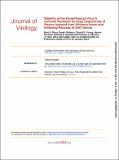Files in this item
Stability of the parainfluenza virus 5 genome revealed by deep sequencing of strains isolated from different hosts and following passage in cell culture
Item metadata
| dc.contributor.author | Rima, Bert K | |
| dc.contributor.author | Gatherer, Derek | |
| dc.contributor.author | Young, Daniel F | |
| dc.contributor.author | Norsted, Hanna | |
| dc.contributor.author | Randall, Richard E | |
| dc.contributor.author | Davison, Andrew J | |
| dc.date.accessioned | 2014-07-03T10:31:06Z | |
| dc.date.available | 2014-07-03T10:31:06Z | |
| dc.date.issued | 2014-04 | |
| dc.identifier | 127302923 | |
| dc.identifier | da4a215f-c359-49ec-b150-638ab45bd6ec | |
| dc.identifier | 24453358 | |
| dc.identifier | 84895456203 | |
| dc.identifier | 000332624700018 | |
| dc.identifier.citation | Rima , B K , Gatherer , D , Young , D F , Norsted , H , Randall , R E & Davison , A J 2014 , ' Stability of the parainfluenza virus 5 genome revealed by deep sequencing of strains isolated from different hosts and following passage in cell culture ' , Journal of Virology , vol. 88 , no. 7 , pp. 3826-3836 . https://doi.org/10.1128/JVI.03351-13 | en |
| dc.identifier.issn | 0022-538X | |
| dc.identifier.other | ORCID: /0000-0002-9304-6678/work/60427040 | |
| dc.identifier.uri | https://hdl.handle.net/10023/4939 | |
| dc.description | This work was supported by the Wellcome Trust (D.F.Y. and R.E.R.), the United Kingdom Medical Research Council (A.J.D. and D.G.), and the University of St. Andrews (H.N.). | en |
| dc.description.abstract | The strain diversity of a rubulavirus, parainfluenza virus 5 (PIV5), was investigated by comparing 11 newly determined and 6 previously published genome sequences. These sequences represent 15 PIV5 strains, of which 6 were isolated from humans, 1 was from monkeys, 2 were from pigs, and 6 were from dogs. Strain diversity is remarkably low, regardless of host, year of isolation, or geographical origin; a total of 7.8% of nucleotides are variable, and the average pairwise difference between strains is 2.1%. Variation is distributed unevenly across the PIV5 genome, but no convincing evidence of selection for antibody-mediated evasion in hemagglutinin-neuraminidase was found. The finding that some canine and porcine, but not primate, strains are mutated in the SH gene, and do not produce SH, raised the possibility that dogs (or pigs) may not be the natural host of PIV5. The genetic stability of PIV5 was also demonstrated during serial passage of one strain (W3) in Vero cells at a high multiplicity of infection, under conditions of competition with large proportions of defective interfering genomes. A similar observation was made for a strain W3 mutant (PIV5VΔC) lacking V gene function, in which the dominant changes were related to pseudoreversion in this gene. The mutations detected in PIV5VΔC during pseudoreversion, and also those characterizing the SH gene in canine and porcine strains, predominantly involved U-to-C transitions. This suggests an important role for biased hypermutation via an adenosine deaminase, RNA-specific (ADAR)-like activity. | |
| dc.format.extent | 11 | |
| dc.format.extent | 1164087 | |
| dc.language.iso | eng | |
| dc.relation.ispartof | Journal of Virology | en |
| dc.subject | Animals | en |
| dc.subject | Genetic Variation | en |
| dc.subject | Genomic Instability | en |
| dc.subject | High-Throughput Nucleotide Sequencing | en |
| dc.subject | Humans | en |
| dc.subject | Molecular Sequence Data | en |
| dc.subject | Parainfluenza Virus 5 | en |
| dc.subject | Rubulavirus Infections | en |
| dc.subject | Serial Passage | en |
| dc.subject | Virus Cultivation | en |
| dc.subject | QR355 Virology | en |
| dc.subject.lcc | QR355 | en |
| dc.title | Stability of the parainfluenza virus 5 genome revealed by deep sequencing of strains isolated from different hosts and following passage in cell culture | en |
| dc.type | Journal article | en |
| dc.contributor.institution | University of St Andrews. School of Biology | en |
| dc.contributor.institution | University of St Andrews. Biomedical Sciences Research Complex | en |
| dc.identifier.doi | https://doi.org/10.1128/JVI.03351-13 | |
| dc.description.status | Peer reviewed | en |
This item appears in the following Collection(s)
Items in the St Andrews Research Repository are protected by copyright, with all rights reserved, unless otherwise indicated.

